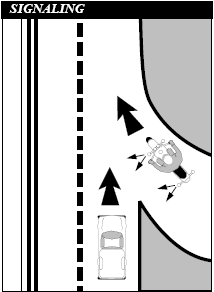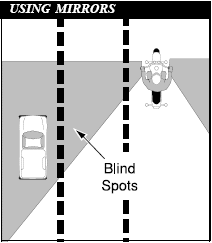Florida Motorcycle Handbook: Increasing Rider Visibility
5. Ride within your Abilities
- 5.1. Basic Vehicle Control
- 5.6. Keeping your Distance
- 5.7. Lane Positions
- 5.8. Following Another Vehicle
- 5.9. Being Followed
- 5.10. Passing and Being Passed
- 5.11. Lane Sharing
- 5.12. Merging Cars
- 5.13. Cars Alongside
- 5.14. S.E.E.
- 5.15. Increasing Rider Visibility
- 5.16. Crash Avoidance
- 5.17. Handling Dangerous Surfaces
- 5.18. Mechanical Problems
- 5.19. Unavoidable Hazards
- 5.20. Getting Off the Road
- 5.21. Carrying Passengers and Cargo
- 5.22. Group Riding
- 5.23. Riding While Impaired
In crashes with motorcyclists, drivers often say that they never saw the motorcycle. From ahead or behind, a motorcycle's outline is much smaller than a car's. Also, it's hard to see something you are not looking for, and most drivers are not looking for motorcycles. More likely, they are looking through the skinny, two-wheeled silhouette in search of cars that may pose a problem to them.
Even if a driver does see you coming, you aren't necessarily safe. Smaller vehicles appear farther away and seem to be traveling slower than they actually are. It is common for drivers to pull out in front of motorcyclists, thinking they have plenty of time. Too often, they are wrong. However, you can do many things to make it easier for others to recognize you and your cycle.
5.15.1 - CLOTHING
Most crashes occur in broad daylight. Wear bright-colored clothing to increase your chances of being seen. Remember, your body is half of the visible surface area of the rider/ motorcycle unit.
Bright orange, red, yellow or green jackets or vests are your best bets for being seen. Your helmet can do more than protect you in a crash. Brightly colored helmets can also help others see you.
Any bright color is better than drab or dark colors. Reflective, bright colored clothing (helmet and jacket or vest) is best.
Reflective material on a vest and on the sides of the helmet will help drivers coming from the side to spot you. Reflective material can also be a big help for drivers coming toward you or from behind.
5.15.2 - HEADLIGHT
The best way to help others see your motorcycle is to keep the headlight on - at all times (although motorcycles sold in the U.S. since 1978 automatically have the headlights on when running.) Studies show that, during the day, a motorcycle with its light on is twice as likely to be noticed. Use of the high beam during the day increases the likelihood that oncoming drivers will see you. Use the low beam at night and in cloudy weather.
5.15.3 - SIGNALS

The signals on a motorcycle are similar to those on a car. They tell others what you plan to do.
However, due to a rider's added vulnerability, signals are even more important. Use them anytime you plan to change lanes or turn. Use them even when you think no one else is around. It's the car you don't see that's going to give you the most trouble. Your signal lights also make you easier to spot. That's why it's a good idea to use your turn signals even when what you plan to do is obvious.
When you enter onto a freeway, drivers approaching from behind are more likely to see your signal blinking and make room for you.
Turning your signal light on before each turn reduces confusion and frustration for the traffic around you. Once you turn, make sure your signal is off or a driver may pull directly into your path, thinking you plan to turn again. Use your signals at every turn so drivers can react accordingly. Don't make them guess what you intend to do.
5.15.4 - BRAKE LIGHT
Your motorcycle's brake light is usually not as noticeable as the brake lights on a car - particularly when your taillight is on. (It goes on with the headlight.) If the situation will permit, help others notice you by flashing your brake light before you slow down. It is especially important to flash your brake light before:
- You slow more quickly than others might expect (turning off a high-speed highway).
- You slow where others may not expect it (in the middle of a block or at an alley).
If you are being followed closely, it's a good idea to flash your brake light before you slow. The tailgater may be watching you and not see something ahead that will make you slow down. This will hopefully discourage them from tailgating and warn them of hazards ahead they may not see.

5.15.5 - USING YOUR MIRRORS
While it's most important to keep track of what's happening ahead, you can't afford to ignore situations behind. Traffic conditions change quickly. Knowing what's going on behind is essential for you to make a safe decision about how to handle trouble ahead.
Frequent mirror checks should be part of your normal searching routine. Make a special point of using your mirrors:
- When you are stopped at an intersection. Watch cars coming up from behind. If a driver isn't paying attention, he can be on top of you before he sees you.
- Before you change lanes. Make sure no one is about to pass you.
- Before you slow down. The driver behind may not expect you to slow, or may be unsure about where you will slow. For example, you signal a turn and the driver thinks you plan to turn at a distant intersection, rather than at a nearer driveway. Some motorcycles have rounded (convex) mirrors. These provide a wider view of the road behind than do flat mirrors. They also make cars seem farther away than they really are. If you are not used to convex mirrors, get familiar with them. (While you are stopped, pick out a parked car in your mirror. Form a mental image of how far away it is. Then, turn around and look at it to see how close you came.) Practice with your mirrors until you become a good judge of distance. Even then, allow extra distance before you change lanes.
5.15.6 - HEAD CHECKS
Checking your mirrors is not enough. Motorcycles have "blind spots" like cars. Before you change lanes, turn your head, and look to the side for other vehicles.
On a road with several lanes, check the far lane and the one next to you. A driver in the distant lane may head for the same space you plan to take.
Frequent head checks should be your normal scanning routine, also. Only by knowing what is happening all around you, are you fully prepared to deal with it.
5.15.6 - HORN
Be ready to use your horn to get someone's attention quickly.
It is a good idea to give a quick beep before passing anyone that may move into your lane.
Here are some situations:
- A driver in the lane next to you is driving too closely to the vehicle ahead and may want to pass.
- A parked car has someone in the driver's seat.
- Someone is in the street, riding a bicycle or walking.
In an emergency, press the horn button loud and long. Be ready to stop or swerve away from the danger.
Keep in mind that a motorcycle's horn isn't as loud as a car's - therefore, use it, but don't rely on it. Other strategies may be appropriate along with the horn.
5.15.7 - RIDING AT NIGHT
At night it is harder for you to see and be seen. Picking your headlight or taillight out of the car lights around you is not easy for other drivers. To compensate, you should:
- Reduce Your Speed - Ride even slower than you would during the day - particularly on roads you don't know well. This will increase your chances of avoiding a hazard.
- Increase Distance - Distances are harder to judge at night than during the day. Your eyes rely upon shadows and light contrasts to determine how far away an object is and how fast it is coming. These contrasts are missing or distorted under artificial lights at night. Open up a three-second following distance or more. And allow more distance to pass and be passed.
- Use the Car Ahead - The headlights of the car ahead can give you a better view of the road than even your high beam can. Taillights bouncing up and down can alert you to bumps or rough pavement.
- Use Your High Beam - Get all the light you can. Use your high beam whenever you are not following or meeting a car. Be visible: Wear reflective materials when riding at night.
- Be Flexible About Lane Position. Change to whatever portion of the lane is best able to help you see, be seen and keep an adequate space cushion.
Check out our Customer Reviews!


